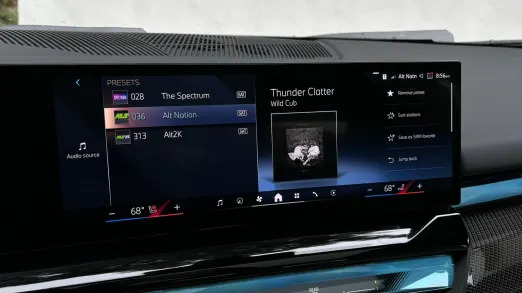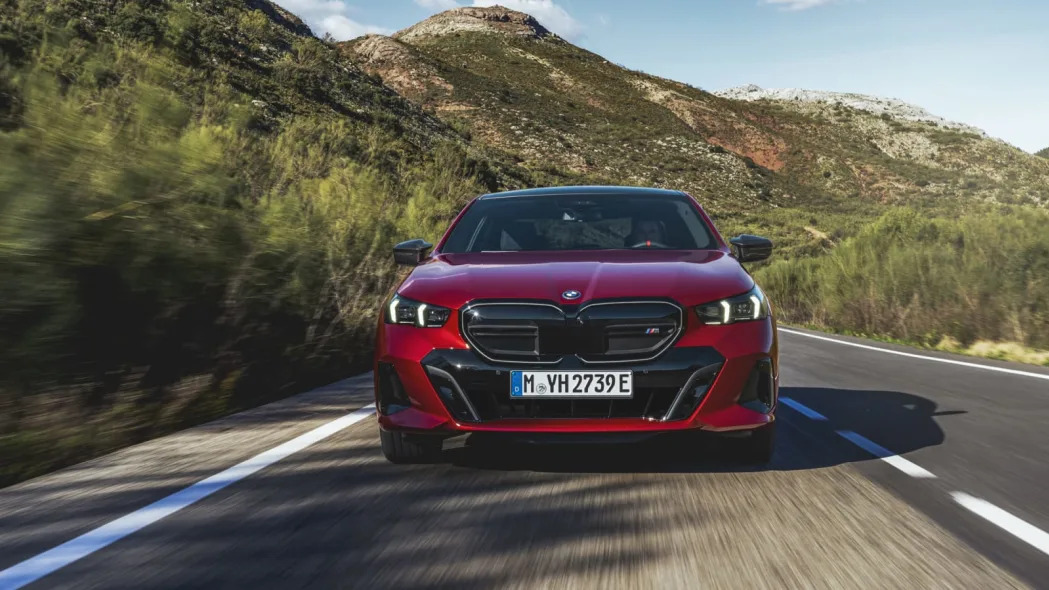Pros: Excellent ride/handling balance; eDrive40’s ample power and range; very cool interior; nutty M60 power; fast charging
Cons: Small, awkwardly shaped trunk; questionable styling, especially the M60
The 2024 BMW i5 is the all-electric version of the new, next-generation 5 Series. You’ll be hard-pressed to tell them apart visually, which is a stark difference from Mercedes’ approach to electrification where the EQE is quite obviously a completely different car from the E-Class – for better and for worse. There are certainly downsides to this concept as well. Sharing a body structure with an internal combustion vehicle means it doesn’t have as much back seat or cargo space as a dedicated EV like the EQE. In general, though, the i5 is a very appealing luxury sedan, arguably moreso than the 5 Series itself. It’s also one of the best electric luxury sedans.
For 2024, there are two versions: the eDrive40 that has a single motor, rear-wheel-drive and a maximum range of 296 miles. The M60 has two motors, all-wheel-drive, and considerably less range, but pumps out 258 more horsepower than the eDrive40. That says more about how nutty the M60 is than anything – the eDrive is already impressive, nail-you-to-your-seat quick. Given its range advantage and overkill nature of the M60’s performance, we think the eDrive40 is the i5 to get.
Noteworthy i5 advantages include a truly inspired ride-handling balance that lets you waft down the road in cocoon-like comfort one minute and expertly carve a canyon the next. The interior is also genuinely cool, with color-changing trim pieces, hidden air vents and big, pretty screens that don’t rob the car of functionality in the process. In short, this is the most compelling 5 Series in a very long time.
Interior & Technology | Passenger & Cargo Space | Performance & Fuel Economy
What it’s like to drive | Pricing & Trim Levels | Crash Ratings & Safety Features
What’s new for 2024?
The i5 is a new model for 2024 and is effectively the all-electric version of the all-new, next-generation BMW 5 Series that will arrive later. Note that there will be a dual-motor, all-wheel drive xDrive40 coming for 2025.



What are the i5 interior and in-car technology like?
The i5 interior is incredibly cool. Climb inside and you’ll notice the strip of colored trim arcing from door to door, and across the dash. That’s pretty neat, but it gets better, because it’s not a traditional trim panel that’ll remain the same as the day it left the factory: It’s actually an ambient lighting panel you can set to your color preference. Another neat detail are hidden air vents controlled with little rubber directional controls (versus frustrating touchscreen controls).
The i5 gets the newest version of BMW’s iDrive infotainment system, and we’re happy to report it’s a massive improvement over its frustrating and overly complicated predecessor. You don’t have to dig into menus so much (most notably to turn on the heated seats) and in general, it’s just easier to use. Natural voice recognition commands are available to help find more in-depth settings (like those ambient lighting colors), while the i5 benefits from BMW choosing to keep the good old-fashioned iDrive control knob around. It’s redundant to be sure and not strictly necessary, but it’s still appreciated for actions where a knob is just better suited, like zooming in/out on a map or wheeling through a list of contacts, radio stations or songs. Menu shortcut buttons are appreciated, too, particularly in Apple CarPlay or Android Auto for quickly toggling between media and navigation.


How big is the i5?
The i5 is 3.4 inches longer than the last-generation 5 Series and 1.4 inches wider. So, yeah, it’s a pretty big sedan – the 7 Series was the same length 20 years ago. It’s also 2.3 inches longer than its most obvious competitor, the Mercedes EQE Sedan, but because the i5 shares its structure with the gas-powered 5 Series, it has a substantially shorter wheelbase than the EQE’s dedicated EV platform. This means it has less back seat legroom – the specs say 1.7 inches, but in our testing, it sure seemed like the Benz had even more. It’s still a big, comfortable back seat, though, with ample headroom (something the swoopy EQE can’t say).
BMW’s specs say that the i5 has 17.3 cubic-feet of trunk space, but there’s no way that number was measured using the same criteria as other brands use. In our cargo testing, it could not fit all six bags from our standard luggage test, something that should theoretically be very easy to do for a trunk with 17.3 cubic-feet (a Honda Accord has 16.7 cubes and can fit a 38-quart cooler in addition to all six bags). This isn’t the first time we’ve come across this situation with BMW. Moreover, the space itself is short in height and awkwardly shaped, though there is a decently sized underfloor storage area. The EQE has a slightly more usable trunk.


What are the i5 range and performance specs?
The 2024 BMW i5 is offered in two models, which correspond to its electric powertrain: the eDrive40 and M60. There will be a third, the xDrive40 coming for 2025 that’ll effectively bridge the gap between the two existing variants.
The i5 eDrive40 has a single motor that powers the rear axle, thereby making it rear-wheel drive. It produces 335 horsepower and 295 pound-feet of torque, which doesn’t seem like a whole lot of torque for an electric motor. Nevertheless, this motor is capable of getting the nearly 5,000-pound i5 up to 60 mph in a rapid 5.7 seconds.
Range for the eDrive40 depends on wheel size. It can go an EPA-estimated 295 miles with the base 19-inch wheels (and its fuel economy is rated at 32 kWh/100 miles), 278 miles with 20-inch wheels (34 kWh/100 miles) or 270 miles with 21-inch wheels (35 kWh/100 miles).
The i5 M60 has two motors, one for each axle, thereby making it all-wheel drive. It produces 593 hp and 586 lb-ft of torque, and hits 60 mph in 3.7 seconds. Range comes in at 256 miles with 19-inch wheels (37 kWh/100 miles), 248 miles with 20s (38 kWh/100 miles) and 240 miles with 21s (40 kWh/100 miles).
The maximum DC fast-charging rate for both is 205 kilowatts, which is among the faster speeds on the market.




i5 eDrive40 top, i5 M60 bottom
What’s the i5 like to drive?
After driving the i5 eDrive40 up a twisting mountain road, it was hard to believe that there needed to be a faster version. Acceleration from the single-motor, rear-drive model was more than enough to make this sizable midsize sedan go way too fast, so packing an additional 258 horses into the same car with the dual-motor i5 M60 just seems a bit nutty.
On that same twisting mountain road, the i5 eDrive40 showed that BMW has regained some of its dynamic verve that’s been missing in the past couple of 5 Series generations. Steering feel still doesn’t match the glory years, but there actually is some. Effort levels feel natural regardless of drive setting. The eDrive40’s available M Sport suspension’s added damping, in addition to the i5’s standard self-leveling rear-axle air springs, impressively settles body motions, resists the effects of mid-corner bumps, and importantly, provides a buttery-smooth ride.
It goes without saying that the i5 M60 is even more fun – and why wouldn’t it be, with 593 hp and 586 lb-ft of torque? The added prowess of all-wheel drive certainly helps this even heftier i5 cut a rug, and even on large 21-inch wheels, the M60’s ride quality remains comfortable and composed. That’s thanks go to M60’s special electronically controlled active dampers. And while it’s far from a track car, the M60’s model-specific rear-wheel steering (up to 2.5 degrees), lower ride height, and active roll stabilization keep it surprisingly nimble and fun on a closed course in the face of its 5,247-pound curb weight.
Like most other EVs, the i5 provides various degrees of regenerative braking. Drivers can choose amongst multiple levels to serve as the default when in Drive, and then turn up the regen dial to max toward one-pedal-driving with the B mode selected more easily with the electronic shifter. There’s a very good chance you’ll find something that works for you, even if that’s driving it like a gas-powered 5 Series with the natural-feeling brake pedal.
What other BMW i5 reviews can I read?
2024 BMW i5 First Drive Review: 5 Series goes electric with aplomb
Look here for more in-depth driving impressions of both the eDrive40 and M60, plus details about its design, engineering and other details about how the i5 came to be.

Why the new 2024 BMW i5 looks just like the new 5 Series
In our exclusive interview with BMW designer Domagoj Dukec, we find out more about why BMW went with electrifying the 5 Series instead of making a separate model.

What is the 2024 i5 price?
The i5 is available as two models that correspond to powertrain. The single-motor, rear-wheel-drive eDrive40 starts at $67,795, including the reasonable $995 destination charge. Opting for the M Sport package pictured throughout this review costs $3,000 and includes special styling flourishes, M wheels and steering wheel, and an M Sport suspension.
The i5 M60 gets two motors and therefore all-wheel drive. Performance is massively increased, and ride/handling are enhanced by a trick 48-volt electrically controlled active anti-roll suspension system. It also gets special styling, but we’re not so sure that’s a win.
Noteworthy options include the Premium package (heated seats and wheel, adaptive cruise control, natural voice recognition controls, a head-up display), the Highway Assistant hands-free adaptive cruise control system, a glass roof, front ventilated seats and leather seating (a very convincing simulated leather available in multiple colors is standard). The last three items are stand-alone options.
What are the i5 safety ratings and driver assistance features?
Every i5 includes forward collision warning, automatic emergency braking, blind-spot warning and lane-departure warning, plus front and rear parking sensors. Adaptive cruise control with stop-and-go capability and lane-centering steering assist is included within one of several packages. The Driving Assistance Professional package goes further with a hands-free adaptive cruise control system.
The i5 had not been crash-tested by a third party at the time of this writing.

